The global mezcal market is projected to grow from USD 640 million in 2025 to approximately USD 1,312 million by 2035, recording an absolute increase of USD 672 million over the forecast period. This translates into a total growth of 105%, with the market forecast to expand at a compound annual growth rate (CAGR) of 7.4% between 2025 and 2035.
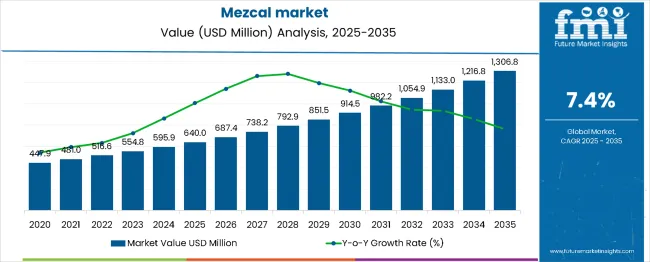
Mezcal Market Key Takeaways
| Metric | Value |
|---|---|
| Estimated Value in (2025E) | USD 640 million |
| Forecast Value in (2035F) | USD 1,312 million |
| Forecast CAGR (2025 to 2035) | 7.4% |
The overall market size is expected to grow by nearly 2.05X during the same period, supported by increasing consumer awareness about craft spirits, rising demand for premium alcoholic beverages, and growing focus on artisanal production methods and authentic heritage experiences.
Between 2025 and 2030, the mezcal market is projected to expand from USD 640 million to USD 924 million, resulting in a value increase of USD 284 million, which represents 42.3% of the total forecast growth for the decade. This phase of growth will be shaped by rising consumer awareness about artisanal spirits, increasing demand for authentic and heritage products, and growing penetration of premium spirits in emerging markets. Beverage and spirits brands are expanding their mezcal product portfolios to address the growing demand for craft spirits solutions with distinctive smoky profiles and traditional production methods.
From 2030 to 2035, the market is forecast to grow from USD 924 million to USD 1,312 million, adding another USD 388 million, which constitutes 57.7% of the overall ten-year expansion. This period is expected to be characterized by expansion of e-commerce channels, integration of advanced production tracking systems in distilleries, and development of limited-edition and celebrity-backed products. The growing adoption of premium spirits trends and mixology culture will drive demand for authentic mezcal products with enhanced quality profiles and sustainable production practices.
Between 2020 and 2025, the mezcal market experienced robust expansion, driven by increasing consumer focus on craft spirits and growing awareness of authentic Mexican heritage beverages. The market developed as spirits brands recognized the need for distinctive products to differentiate from mainstream tequila offerings. Social media influence and bartender recommendations began emphasizing the importance of mezcal in premium cocktail culture for delivering unique smoky flavor experiences and artisanal authenticity.
Market expansion is being supported by the increasing consumer awareness about artisanal spirits and the corresponding demand for authentic heritage beverages with distinctive flavor profiles. Modern consumers are increasingly focused on premium spirits that offer unique sensory experiences, traditional production methods, and authentic regional characteristics. Mezcal's proven authenticity through traditional production methods and denomination of origin protections makes it a preferred choice in premium spirits segments focused on craft experiences and cultural heritage.
The growing emphasis on craft spirits and authentic ingredients is driving demand for mezcal products produced using traditional methods such as clay pot distillation and natural fermentation. Consumer preference for distinctive products that combine heritage authenticity with premium positioning is creating opportunities for artisanal producers and specialty formulations. The rising influence of mixology culture and bartender recommendations is also contributing to increased product adoption across different demographics and sophisticated consumer segments seeking unique drinking experiences.
The market is segmented by product, source, concentration, and region. By product, the market is divided into Joven, Reposado, Añejo, and Tobaziche. Based on source, the market is categorized into Espadín, Tobalá, Tobaziche, Tepeztate, and Arroqueño.
In terms of concentration, the market is segmented into 100% agave mezcal and blends. Regionally, the market is divided into North America, Latin America, Western Europe, Eastern Europe, East Asia, South Asia & Pacific, Central Asia, Russia and Belarus, Balkan & Baltic Countries, and Middle East & Africa.
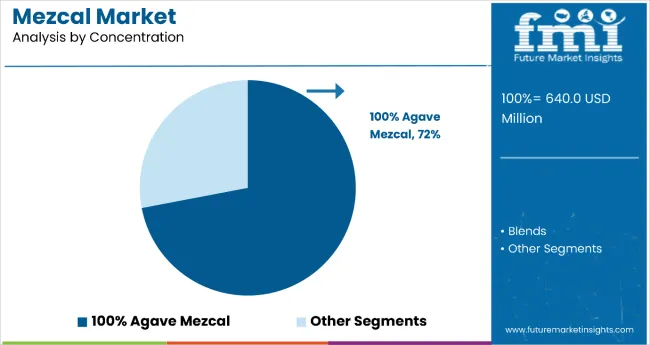
The 100% agave mezcal concentration is projected to account for 72% of the mezcal market in 2025, reaffirming its position as the category's premium standard. Consumers increasingly understand the link between authentic production methods, pure agave content, and superior flavor profiles that define traditional mezcal craftsmanship. Pure agave mezcal's well-documented authenticity directly addresses consumer demands for heritage spirits by maintaining traditional production standards, preventing dilution with other ingredients, and supporting artisanal producer communities.
This concentration forms the foundation of most premium positioning, as it represents the most recognizable and tradition-backed standard of mezcal production. Denomination of origin certifications and ongoing quality validation continue to strengthen trust in 100% agave formulations.
With consumer preferences increasingly focused on authentic spirits experiences, pure agave concentration aligns with both premium positioning and cultural preservation goals. Its broad appeal across sophisticated demographics ensures sustained dominance, making it the central growth driver of mezcal market demand.
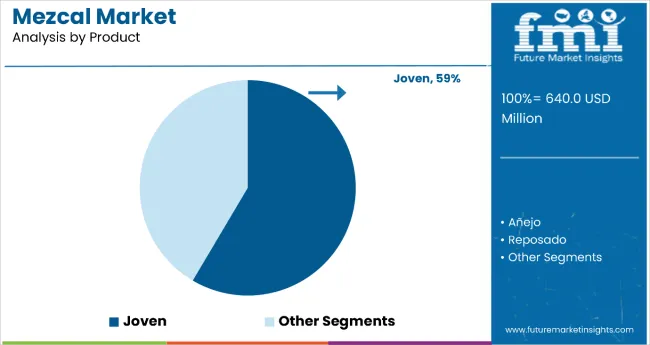
Joven mezcal is projected to represent 59% of mezcal demand in 2025, underscoring its role as the preferred product type for experiencing pure agave expression. Consumers gravitate toward Joven for its unaged character, vibrant agave flavors, and ability to showcase the distinctive terroir characteristics of specific agave varieties and production regions. Positioned as the authentic baseline for mezcal appreciation, Joven offers both sipping experiences for connoisseurs and mixability benefits for creative cocktail applications.
The segment is supported by the growing popularity of artisanal spirits appreciation, where Joven plays a central role in education and authenticity positioning. Additionally, producers are increasingly focusing on single-village Joven expressions, estate-specific batches, and wild agave varieties, enhancing appeal and supporting premium price points. As ingredient-conscious consumers prioritize authenticity and traditional production methods, Joven-based mezcals will continue to dominate demand, reinforcing their foundational positioning within the premium spirits market.
The mezcal market is advancing rapidly due to increasing consumer awareness about craft spirits and growing demand for authentic heritage beverages with distinctive flavor profiles. However, the market faces challenges including agave supply constraints, production capacity limitations, and regulatory compliance requirements for denomination of origin certification. Innovation in sustainable agave cultivation and traditional production scaling continue to influence market development and expansion strategies.
Expansion of E-commerce and Direct-to-Consumer Channels
The growing adoption of e-commerce platforms is enabling mezcal brands to reach consumers directly and provide detailed product education about production methods and heritage. Online channels offer convenience, comprehensive product information, and access to limited-edition releases that influence purchasing decisions.
Social media marketing and influencer partnerships are driving brand awareness and product adoption, particularly among younger demographics who prefer online discovery experiences and value authentic brand storytelling.
Integration of Advanced Production Tracking and Quality Systems
Modern mezcal producers are incorporating blockchain-enabled traceability systems, PLC-driven micro-dosing equipment, and automated bottling technologies to enhance production consistency while maintaining artisanal authenticity.
These technologies improve quality control and regulatory compliance while extending product shelf life and providing better consumer confidence. Advanced tracking techniques also enable single-batch identification and limited-edition positioning that deliver premium experiences in specialized applications.
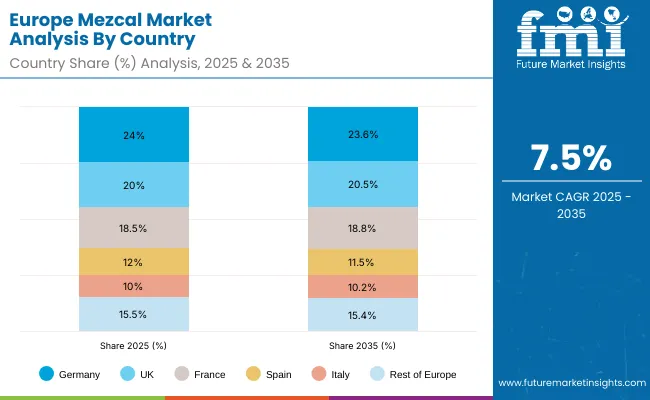
The mezcal market in Europe is projected to grow from USD 128.0 million in 2025 to USD 263.0 million by 2035, registering a CAGR of 7.5% over the forecast period. Germany is expected to lead the region with 24.0% market share in 2025, moderating slightly to 23.6% by 2035, supported by a sophisticated spirits-appreciation culture and strong on-trade (bars/restaurants) adoption of craft agave expressions.
The United Kingdom follows with 20.0% in 2025, rising to 20.5% by 2035, driven by vibrant cocktail culture, premium bar listings, and specialty importers championing mezcal. France accounts for 18.5% in 2025, edging to 18.8% by 2035 as luxury spirits retailers and fine-dining establishments embrace terroir-driven mezcal. Spain holds 12.0% in 2025, easing to 11.5% by 2035, with growth concentrated in premium hospitality and tourist-oriented venues.
Italy represents 10.0% in 2025, moving to 10.2% by 2035, supported by rising mixology and premium spirits interest. The remainder of Europe (Nordic countries, BENELUX, Eastern Europe and other markets) collectively contributes 15.5% in 2025, adjusting to 15.4% by 2035, reflecting steady import growth and expanding specialist retail and on-trade distribution across niche premium segments.
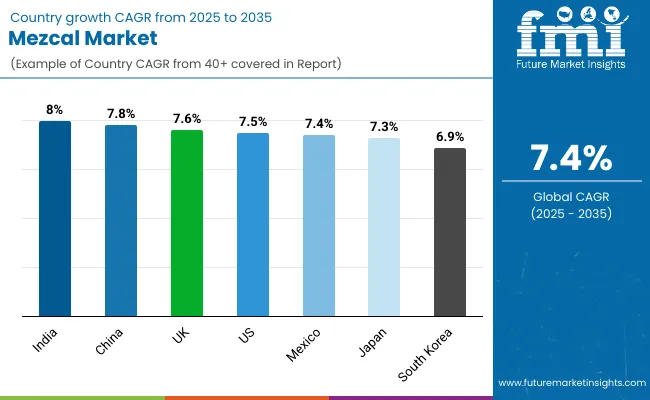
| Country | CAGR (2025 to 2035) |
|---|---|
| India | 8.0% |
| China | 7.8% |
| UK | 7.6% |
| US | 7.5% |
| Mexico | 7.4% |
| Japan | 7.3% |
| South Korea | 6.9% |
The mezcal market is experiencing robust growth globally, with India leading at an 8.0% CAGR through 2035, driven by rising disposable income, increasing appreciation for premium spirits, and growing penetration of international beverage brands in metropolitan markets. China follows closely at 7.8%, supported by strong e-commerce infrastructure, lifestyle premiumization, and increasing demand for authentic international spirits.
The UK shows strong growth at 7.6%, emphasizing cocktail culture trends and premium spirits appreciation. The US records 7.5%, focusing on craft spirits movements and heritage authenticity trends. Mexico shows 7.4% growth, balancing domestic consumption with export market development.
The report covers an in-depth analysis of 40+ countries; seven top-performing countries are highlighted below.
Revenue from mezcal in India is expanding at a CAGR of 8.0%, supported by increasing disposable income, growing appreciation for premium international spirits, and rising penetration of authentic craft brands. The country's young demographic profile and increasing exposure to global cocktail culture are driving demand for distinctive spirits experiences and heritage authenticity. International spirits importers and domestic distributors are establishing specialized channels to serve the growing demand for premium agave-based products.
Revenue from mezcal in China is projected to exhibit strong growth with a CAGR of 7.8% through 2035, driven by rapid adoption of premium spirits among younger consumers and increasing influence of international cocktail culture. The country's expanding affluent class and growing appreciation for authentic international products are creating significant demand for heritage spirits. Major international importers and domestic distributors are establishing comprehensive networks to serve the growing population of premium spirits enthusiasts across tier-1 and tier-2 cities.
Demand for mezcal in the USA is projected to grow at a CAGR of 7.5%, supported by consumer preference for craft spirits and authentic heritage products with distinctive regional characteristics. American consumers are increasingly focused on artisanal authenticity, traditional production methods, and sustainable spirits practices. The market is characterized by strong demand for premium expressions that combine traditional mezcal production with sophisticated flavor profiling for enhanced cocktail applications and neat consumption experiences.
Revenue from mezcal in the UK is projected to grow at a CAGR of 7.6% through 2035, supported by the country's strong cocktail culture, premium spirits appreciation, and consumer preference for authentic international products with distinctive characteristics. British consumers consistently value heritage authenticity, production transparency, and innovative mixology applications, positioning mezcal as a core component of sophisticated beverage experiences.
Revenue from mezcal in Mexico is projected to grow at a CAGR of 7.4% through 2035, driven by the country's foundational role in authentic production, domestic premium consumption growth, and expanding tourism focused on mezcal heritage regions. Mexican consumers demonstrate increasing appreciation for premium domestic expressions, artisanal producer support, and regional authenticity preservation.
Revenue from mezcal in Japan is projected to grow at a CAGR of 7.3% through 2035, supported by the country's strong emphasis on artisanal product appreciation, terroir-driven beverage understanding, and premium spirits culture. French consumers prioritize authenticity, traditional production methods, and cultural heritage, making mezcal an appealing choice in the luxury international spirits segment.
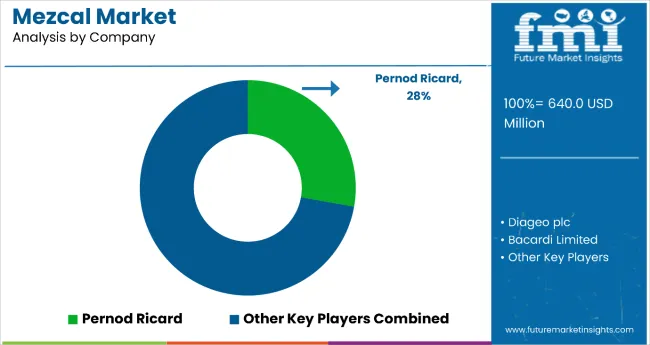
The mezcal market is characterized by competition among established spirits conglomerates, artisanal producers, and emerging craft spirits companies. Companies are investing in sustainable agave cultivation, traditional production method preservation, premium packaging, and cultural education strategies to deliver authentic, appealing, and accessible heritage spirits experiences. Brand positioning, production authenticity, and distribution expansion are central to strengthening product portfolios and market presence.
Pernod Ricard leads the market with approximately 28% global value share, offering premium mezcal brands with a focus on traditional production authenticity and heritage preservation. Diageo plc provides established distribution networks with emphasis on artisanal producer partnerships and sustainable sourcing practices. Bacardi Limited delivers comprehensive mezcal portfolios with focus on premium positioning and cultural authenticity education. Brown-Forman Corporation emphasizes heritage brand development and traditional production method preservation.
Constellation Brands and Campari Group, operating internationally, provide comprehensive mezcal product ranges across multiple price points and distribution channels. LVMH Moët Hennessy Louis Vuitton emphasizes luxury positioning and authentic heritage preservation with premium artisanal partnerships. Beam Suntory offers traditional production support with focus on sustainable agave cultivation and producer community development. Heaven Hill Brands and Rémy Cointreau provide specialized premium solutions with focus on authentic regional expressions and traditional production method preservation.
The success of mezcal, fueled by premium spirits demand, cultural authenticity, and sustainability-linked sourcing, will not only elevate agave-based beverages globally but also strengthen rural economies and heritage farming.
It will consolidate producing regions in Mexico as global hubs for artisanal and certified spirits while aligning advanced economies with premium, traceable, and ESG-compliant alcoholic beverages. This calls for a concerted effort by all stakeholders: governments, industry bodies, suppliers, OEMs, and investors. Each can be a crucial enabler in preparing the market for its next phase of growth.
| Items | Values |
|---|---|
| Quantitative Units (2025) | USD 640 Million |
| Product | Joven, Reposado, Añejo, Tobaziche |
| Source | Espadín, Tobalá, Tobaziche, Tepeztate, Arroqueño |
| Concentration | 100% Agave Mezcal, Blends |
| Regions Covered | North America, Latin America, Western Europe, Eastern Europe, East Asia, South Asia & Pacific, Central Asia, Russia and Belarus, Balkan & Baltic Countries, Middle East & Africa |
| Countries Covered | United States, Japan, Germany, India, United Kingdom, France, Italy, Brazil, Canada, South Korea, Australia, Spain, Netherlands, Saudi Arabia, Switzerland and 40+ countries |
| Key Companies Profiled | Pernod Ricard, Diageo plc, Bacardi Limited, Brown-Forman Corporation, Constellation Brands, Campari Group, LVMH Moët Hennessy Louis Vuitton, Beam Suntory, Heaven Hill Brands, and Rémy Cointreau |
| Additional Attributes | Premium positioning trends, artisanal production methods, e-commerce growth, sustainable agave cultivation practices, traditional production preservation, heritage authenticity positioning, denomination of origin certification, limited-edition releases, and celebrity partnership strategies |
The mezcal market is poised to reach USD 640 million in 2025.
The mezcal industry is projected to reach USD 1,312 million by 2035.
Joven mezcal is the most widely consumed due to its affordability and mixability.
India, slated to grow at an 8.0% CAGR during the study period, is poised for the fastest growth in the industry.
Key companies in the companies include Pernod Ricard, Diageo plc, Bacardi Limited, Brown-Forman Corporation, Constellation Brands, Campari Group, LVMH Moët Hennessy Louis Vuitton, Beam Suntory, Heaven Hill Brands, Rémy Cointreau, and other industry players.






Our Research Products

The "Full Research Suite" delivers actionable market intel, deep dives on markets or technologies, so clients act faster, cut risk, and unlock growth.

The Leaderboard benchmarks and ranks top vendors, classifying them as Established Leaders, Leading Challengers, or Disruptors & Challengers.

Locates where complements amplify value and substitutes erode it, forecasting net impact by horizon

We deliver granular, decision-grade intel: market sizing, 5-year forecasts, pricing, adoption, usage, revenue, and operational KPIs—plus competitor tracking, regulation, and value chains—across 60 countries broadly.

Spot the shifts before they hit your P&L. We track inflection points, adoption curves, pricing moves, and ecosystem plays to show where demand is heading, why it is changing, and what to do next across high-growth markets and disruptive tech

Real-time reads of user behavior. We track shifting priorities, perceptions of today’s and next-gen services, and provider experience, then pace how fast tech moves from trial to adoption, blending buyer, consumer, and channel inputs with social signals (#WhySwitch, #UX).

Partner with our analyst team to build a custom report designed around your business priorities. From analysing market trends to assessing competitors or crafting bespoke datasets, we tailor insights to your needs.
Supplier Intelligence
Discovery & Profiling
Capacity & Footprint
Performance & Risk
Compliance & Governance
Commercial Readiness
Who Supplies Whom
Scorecards & Shortlists
Playbooks & Docs
Category Intelligence
Definition & Scope
Demand & Use Cases
Cost Drivers
Market Structure
Supply Chain Map
Trade & Policy
Operating Norms
Deliverables
Buyer Intelligence
Account Basics
Spend & Scope
Procurement Model
Vendor Requirements
Terms & Policies
Entry Strategy
Pain Points & Triggers
Outputs
Pricing Analysis
Benchmarks
Trends
Should-Cost
Indexation
Landed Cost
Commercial Terms
Deliverables
Brand Analysis
Positioning & Value Prop
Share & Presence
Customer Evidence
Go-to-Market
Digital & Reputation
Compliance & Trust
KPIs & Gaps
Outputs
Full Research Suite comprises of:
Market outlook & trends analysis
Interviews & case studies
Strategic recommendations
Vendor profiles & capabilities analysis
5-year forecasts
8 regions and 60+ country-level data splits
Market segment data splits
12 months of continuous data updates
DELIVERED AS:
PDF EXCEL ONLINE
Mezcal Industry Analysis in Japan - Consumer Demand & Industry Trends in 2025
Mezcal Industry Analysis in Korea – Trends, Demand & Industry Growth
Mezcal Industry Analysis in Western Europe Report – Growth, Demand & Forecast 2025 to 2035
Market Share Insights of Leading Mezcal Manufacturers
UK Mezcal Market Growth – Innovations, Trends & Forecast 2025-2035
USA Mezcal Market Analysis – Size, Share & Trends 2025-2035
ASEAN Mezcal Market Report – Trends, Demand & Industry Forecast 2025-2035
Europe Mezcal Market Insights – Size, Share & Growth 2025-2035
Australia Mezcal Market Trends – Growth, Demand & Forecast 2025-2035
Demand for Mezcal in EU Size and Share Forecast Outlook 2025 to 2035
Latin America Mezcal Market Outlook – Trends, Growth & Forecast 2025-2035

Thank you!
You will receive an email from our Business Development Manager. Please be sure to check your SPAM/JUNK folder too.
Chat With
MaRIA